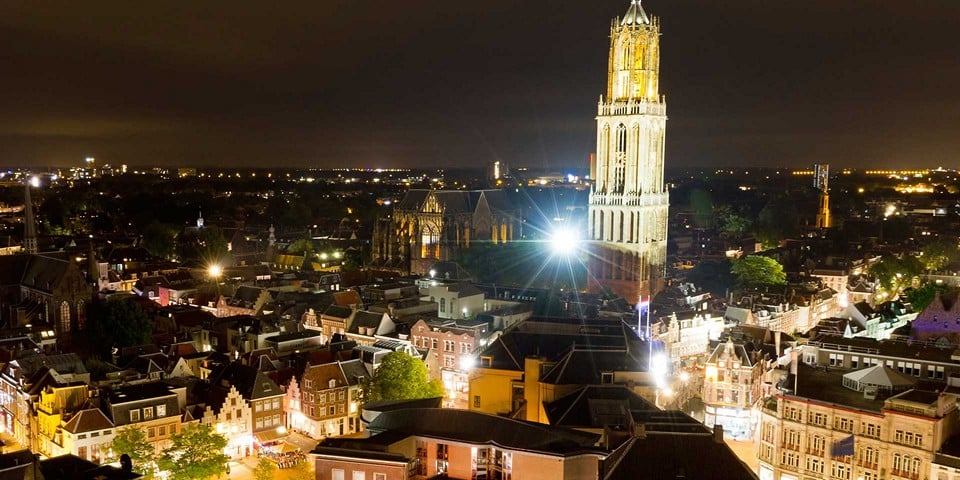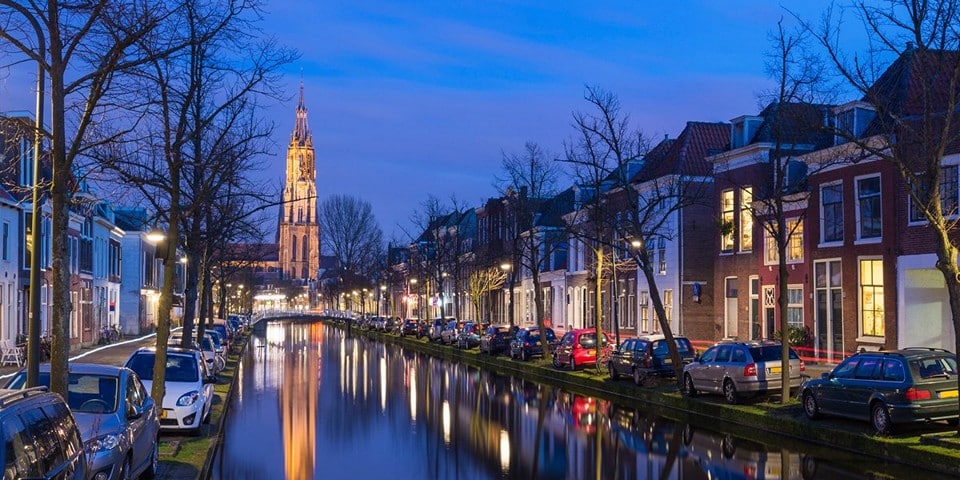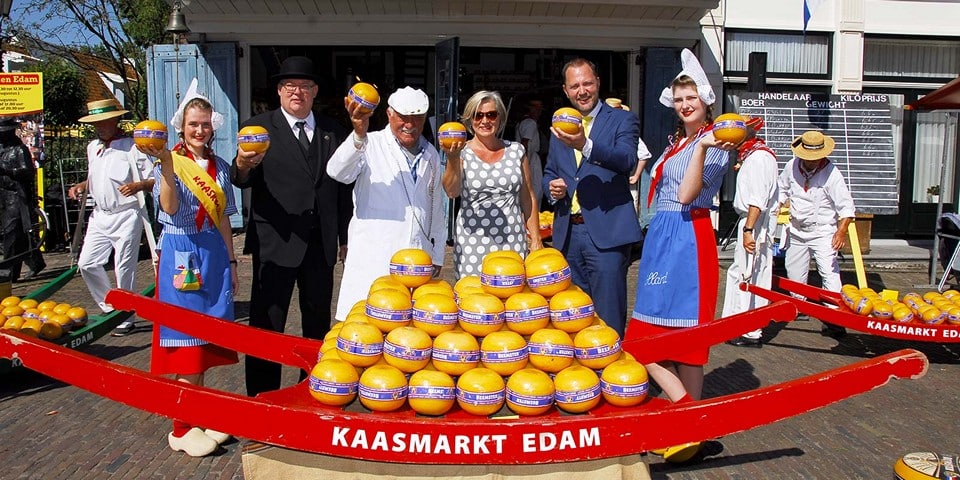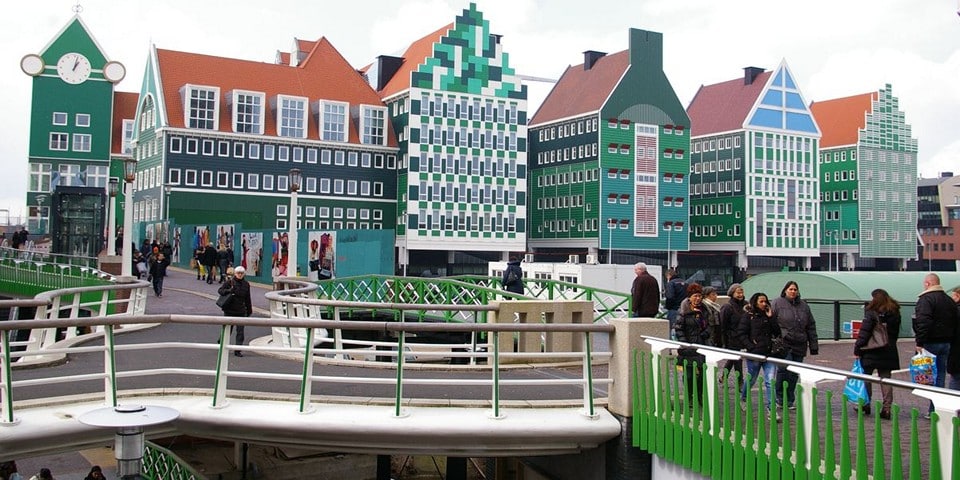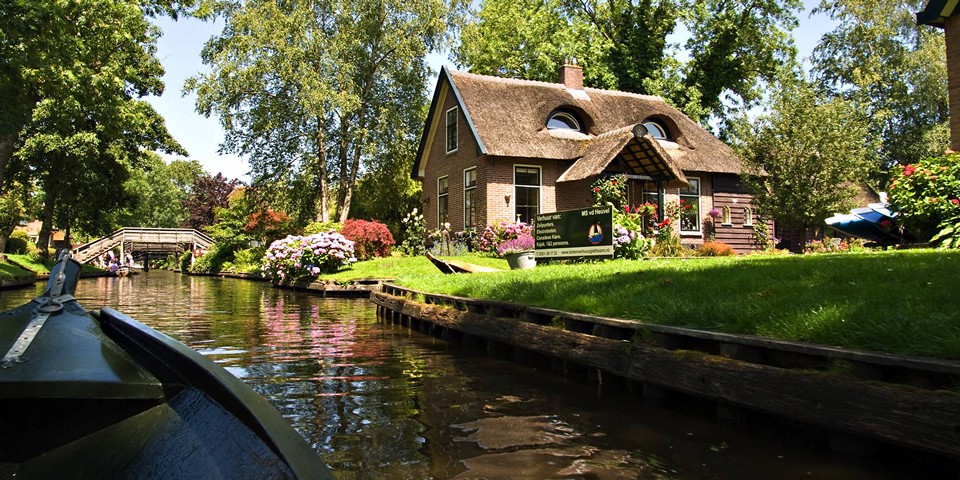If you want to meet a member of the royal house of the Netherlands in an intimate setting, you should go to Leiden. Here is the oldest university in the country, which was once graduated by King Willem-Alexander, and is now being studied by members of the royal family. It should be noted that the local university is not the only attraction of Leiden. Castles, medieval walls, temples and walls painted with the poems of the classics of world literature cannot but attract attention.
Geography
Leiden is located in the province of South Holland (Zuid-Holland) between The Hague (The city of Den Haag, the seat of parliament and home of the royal family, and Amsterdam, the capital of the Netherlands. Leiden is separated from The Hague by 17 km, from Amsterdam by a straight line of 36 km.
The area of Leiden is 23.37 km2, which is inhabited by more than 123 thousand people. Thus, There are 5,099 people living here per square kilometerand therefore the city is one of the most densely populated areas of the Netherlands.
There are many canals in Leiden, the most famous of which is located in the center of Rapenburg.
The city owes its canals above all to the rivers that flow into it. From the east, the Old Rhine (Oude Rijn) flows into Leiden, which first runs along the outskirts to the north and then splits into two branches. One keeps the Old Rhine flowing, the other the New Rhine (Nieuwe Rijn). They flow northwest through a system of canals, and at some point converge into the Rijn, which leaves Leiden in the west and flows northward, flowing into the North Sea.
On the southwestern side, the Vliet River flows into the city and then splits into two streams. The Vliet itself runs through the city to the northeast and then diverges again. The Vliet itself runs through the city to the northeast, then diverges again. The Trekvliet canal runs from it toward the Rhine, while the Rijn-Schiekanaal continues to flow northeast. It crosses the two canals of the Old Rhine and directly crosses into the De Zijl River, which flows into the large Het Joppe, a few kilometers north of Leiden. This river separates Leiden from Leiderdorp.
Many canals flow through parks or green spaces.
Among them is the oldest botanical garden in the Netherlands, Hortus botanicus Leiden, which was founded at Leiden University in 1590 on the Rapenburg Canal.
History
Early period
However, people lived here during the Roman Empire and the first archaeological finds date back to the Stone Age (2,000 B.C.). In addition, In the western part of Leiden the remains of houses and a wooden road were found dating back to 500 BC. In those days the area was swampy, with numerous streams and rivers that flowed into the Rhine. Therefore it was difficult for people to form a large settlement, they lived on farms and were engaged in cattle breeding, fishing and waterfowl hunting. Farming was poorly developed because the area was too marshy.
In the first century A.D., first Germanic, then Roman tribes settled here. In 90 AD, the province of Lower Germany (lat. Germania Inferior) appeared, becoming part of the Roman Empire. Its border ran along the Rhine, along which the Romans built a network of forts. One of them, Lugdunum Batavorum, has long been associated with Leiden and even named the local university Academia Lugduno Batava in Latin. For a long time it was thought that the name of the city came from this fort.
But later it was proved that there was a mistake, and Lugdunum Batavorum was located closer to the sea. And in the area of Leiden after 69 AD there was another fort, Matilon. Presumably, it was in the area of Leiderdorp, which is separated from Leiden by the river De Zijl. The garrison consisted of 480 Roman soldiers and there was a settlement near the fort, where half a thousand people lived, most of whom served the fort. In the middle of III century, the Romans left Matilon and the tribes who came here used the stones from the fort to build new fortifications, houses, crossed the river and began to settle the land of Leiden.
The emergence of the city
The first settlement, which is considered the predecessor of modern Leiden, began to form at the confluence of the Old and New Rhine in the IX century near an artificial hill, which people built to hide from the floods. Then a fort appeared on the mound and the hill was made higher by fortifying the slopes. In this castle hid the locals during the raids of the Normans. The locals called their settlement Leithon and the land belonged to the bishop of Utrecht.
The area where Leiden was located was a strategically important place where there was a struggle between the Counts of Holland and the German emperors.
That's why there was a lot of warfare here for many centuries. However, this did not hinder the development of trade, which was facilitated by the location of the city at the confluence of two navigable rivers. As a result, a large market developed at the foot of the hill where the castle was located. After Leiden came under the control of the Counts of Holland, a count's residence was built in the southern part of the city.
In the twelfth century, the Rhine delta near Leiden silted up, causing the waters to slow down considerably and endangering trade. This gave rise to the first Dutch commission with water issues, Waterschap, whose task was to solve the problem.
In the XIII century Leiden was given city rights, which allowed it to become an administrative, economic and shipping center.
The city began to expand and the population grew steadily. Craftsmen from all over the region began to arrive here, and the textile industry became the basis of the economy. In the middle of the 14th century the construction of protective walls began, but even earlier the defense canal Rapenbürg.
Middle Ages
In the 16th century, due to numerous civil wars, Leiden's economy was in crisis. At the time of the Dutch Revolution, the townspeople joined the rebels against Spanish rule - and the city suffered two sieges. After Leiden survived the second siege, William I of Orange offered them a reward: a reduction in taxes or the opening of a university. The townspeople chose the second option and do not regret it to this day.
It is interesting that During the siege of Leiden, paper money was used for the first time in Europe. There was not enough silver to make coins, so it was decided to use stamped sheets from prayer books as currency.
After the victory of the revolution, Leiden began to experience an economic boom, and many Protestants who had not been supported in their homeland began to come here. The university played an important role here, and became one of the most important scientific centers in Europe. In 1581 the Elsevier printers moved here and established a publishing house.
Leiden's population grew enormously. After the siege was lifted in 1574 it had 15,000 inhabitants, a hundred years later it had 63,000, notwithstanding the fact that the city had several times survived the plague.
The New Story
At the end of the seventeenth century economic decline began. One of the reasons for this was the high cost of production, so factories began to move to other, cheaper regions, which led to a sharp decline in the population to 30 thousand people, a quarter of whom lived below the poverty line. In the XX century this problem has been solved: Leiden is again experiencing a period of prosperity. Various commercial and industrial enterprises are concentrated here, and new residential areas have emerged outside the historical part of the city.
Attractions
Ironically, the economic downturn of the eighteenth and nineteenth centuries did Leiden's sights good. Because of the difficult economic situation, the authorities did not carry out large-scale construction projects, thanks to which the historical part of the city, built up mainly in the XVI-XVII centuries, remained untouched.
University and Botanical Gardens
Leiden's main attraction is the De Universiteit Leiden, founded by William I of Orange in 1575 after the lifting of the Spanish siege. The university is housed in several historic and new buildings. In the main building, which is located in the city center, there is only administration, there are no classrooms. It is also home to the oldest botanical garden in the country, Hortus botanicus Leiden, of which the university is the founder.
Leiden University has seven faculties with almost 25,000 students. Studying costs are high: to become a bachelor, citizens must pay from $ 2.5 thousand, foreigners - from $ 11.5 thousand, depending on the department. And that's not counting living expenses and tuition. Master's programs are more expensive, and the price increases every year. But such fees are justified: 16 Nobel laureates among the graduates of Leiden University.
Albert Einstein taught here, and René Descartes and Benedict Spinoza studied science.
It is a very prestigious university, which is why the Royal House of the Netherlands traditionally sends members of its family to study here. The University of Leiden was once graduated by Queens Wilhelmina (who ruled from 1890 to 1948), Juliana (1848-1980) and Beatrix (1980-2013), as well as King Willem-Alexander, who rules the country today. It is noteworthy that all the monarchs of the Netherlands who ruled the country in the twentieth century voluntarily abdicated in favor of their heirs.
- Address of the main building and botanical garden: Rapenburg,73;
- University website: www.universiteitleiden;
- Botanical Garden website: www.hortusleiden;
- Botanical Garden opening hours: in summer - from 10 to 18, on Wednesday, Saturday and Sunday from 11 to 16. From November 1 to March 31 - 10 a.m. to 4 p.m. Tours from 11:30 a.m. to 3 p.m. Last admission half an hour before closing time;
- Entrance fee to the Botanical Gardens: adults 7.5 €, children 3 €, students and staff of Leiden University 2 €.
Leiden Castle
The fortress Burcht van Leiden, known as the Leiden Castle, can be considered as the first building of Leiden. It was built in the 11th century on an artificial hill. At first the fortress was wooden, but soon enough it was replaced by a stone constructionIt is an example of one of the oldest examples of a defensive fortress. The diameter of the fortress is 35.5 m, height and thickness of the walls is 6.2 m and 90 cm respectively. From the walls of the fort you can enjoy a beautiful view of Leiden.
Unfortunately, the economic and residential buildings of the fort have not survived. After the fort lost its defense importance in the XIII century, its tower was dismantled for the construction of other houses. In 1861 the structure was purchased by the city council, which placed a water tower there. A year later, a new gate with the coats of arms of the noble families of Leiden appeared. Two portals have survived to this day: the forged one at the foot of the hill (1653) and the one at the entrance on the southern side of the park surrounding the castle.
- Address: Van der Sterrepad;
- Web site: www.visitleiden;
- Opening hours: from 8 to 22;
- Admission is free.
St. Peter's Church
The oldest church in the city is the Church of St. Peter (Pieterskerk), construction of which began in 1390 and lasted 180 years. Before that, there was a chapel of the Counts of Holland, built in the 12th century. As the city was expanding rapidly, it was necessary to build a new building. In order not to interrupt the services, they began to build additional rooms around the chapel - and it slowly dissolved into the new building. In 1350, a tower appeared which was used as a lighthouse. It was built in several stages until it reached its final height of 70 meters. In 1512, the tower collapsed and no new one was built.
The stained glass windows and windows of the temple, which the visitor can now see, are quite new. In 1807, a tragedy occurred in the center of Leiden: 17 tons of gunpowder exploded on a ship in the city, resulting in the loss of life and the destruction of many buildings. Among them, the windows of St. Peter's Church were broken. The consequences of this catastrophe, as well as the wars that swept Europe in the 20th century, were eliminated only at the beginning of the 21st century during an overhaul.
Pieterskerk after reconstruction was opened in 2011, but it is not used as a temple. Now tours, conferences, exhibitions, scientific and cultural events are held here.
- Address: Kloksteeg, 16;
- Web site: www.pieterskerk;
- Ticket: 3 €, tour for 15 people. - from 75 €.
Hooglanse Church
Leiden's largest active Protestant church is the Hooglandse Kerk, built in the Gothic style. The construction of the church began in 1377 on the site of an old chapel. The church is distinguished not only by its striking appearance, but also by its colossal size: its length and width is about 70 m, the height of the vaults of the transept and the choir is 26.2 m.
Throughout its history, the Hooglandse Kerk has been rebuilt more than onceIn the period of iconoclasm the church lost many artifacts, so nothing of the original Catholic decorations remained. The church was severely damaged in a gunpowder explosion in 1807, and it took a century to restore it.
The church is now in very good condition, and so it not only hosts Protestant services, but also various concerts and conferences.
- Address: Nieuwstraat, 20;
- Web site: hooglandsekerk.com
How to get
From the Dutch capital to Leiden is convenient to get by train or bus. Amsterdam is located from Leiden at a distance of 36 km in a straight line and 43 km by road, so the road takes from 20 to 50 minutes.
By train
The fastest way to get from Amsterdam to Leiden is by train.
If you leave from Station Amsterdam-Zuid, the journey takes 21 minutes, while from Amsterdam Centraal the route is fifteen minutes longer. But keep in mind that from Amsterdam-Zuid trains go every half hour, while from the central station every 5-10 minutes. After one o'clock in the morning until six in the morning trains from Amsterdam go once an hour. Some routes run through Schiphol Airport.
The fare in second class will cost 9 €, in first class - 15,3 €. More details about the schedule, ticket prices and itinerary can be found on the website www.ns.nl
By car
By car from Amsterdam to Leiden can be reached in 50 minutes if you drive on the highway A. The length of the road is 42.7 km.
To get from Amsterdam to Leiden, first take the A10 (Amsterdam Nieuw-West) via Raadhuisstraat, Tweede Hugo de Grootstraat and Jan van Galenstraat/s105. Then, drive to the A4, then head in the direction of Provincialeweg (Oud Ade). Take the A4/E19 to exit 6-Hoogmade and then turn off at Hoogmade/Leiden-Noord/Leiderdorp and continue on Provincialeweg. Then go through Kooilaan, Herensingel, Langegracht, Klokpoort, Pelikaanstraat, heading towards Gepekte Brug (Leiden).
Why come here
Leiden sights annually attract tens of thousands of tourists. Cosy streets, medieval walls and gates, castles, temples, city mills, a botanical garden and a weighing house. In total, Leiden has 1250 national and 1550 municipal monuments, 4.5 thousand iconic buildings and two archaeological sites that are worth seeing for everyone.











